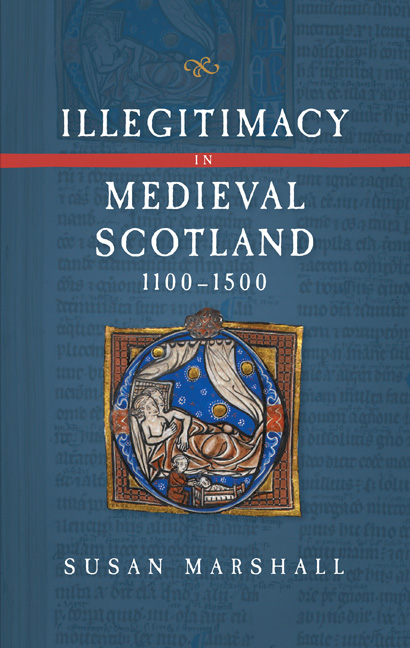Book contents
- Frontmatter
- Dedication
- Contents
- List of Tables
- Preface
- Acknowledgements
- Abbreviations
- Introduction
- 1 Church law and Scottish Families
- 2 Illegitimacy and Inheritance
- 3 Illegitimacy and Royal Succession I: Before the Great Cause
- 4 Illegitimacy and Royal Succession II: from the Great Cause to James I
- 5 Wives, Daughters, and Sisters
- 6 Church Careers and Sacrilegious Bastards
- 7 Illegitimacy in Political Life
- Conclusion
- Appendix I Scottish kings and their illegitimate offspring
- Appendix II Illegitimate sons of Scottish kings
- Timeline of key events
- Bibliography
- Index
3 - Illegitimacy and Royal Succession I: Before the Great Cause
Published online by Cambridge University Press: 26 March 2021
- Frontmatter
- Dedication
- Contents
- List of Tables
- Preface
- Acknowledgements
- Abbreviations
- Introduction
- 1 Church law and Scottish Families
- 2 Illegitimacy and Inheritance
- 3 Illegitimacy and Royal Succession I: Before the Great Cause
- 4 Illegitimacy and Royal Succession II: from the Great Cause to James I
- 5 Wives, Daughters, and Sisters
- 6 Church Careers and Sacrilegious Bastards
- 7 Illegitimacy in Political Life
- Conclusion
- Appendix I Scottish kings and their illegitimate offspring
- Appendix II Illegitimate sons of Scottish kings
- Timeline of key events
- Bibliography
- Index
Summary
Quhow euir it be, a kingis sone am I,
Suppois I gottin was onlauchfullie
In 787, a council of Anglo-Saxon and Carolingian clergy at Chelsea agreed that kingship was a special vocation from which men born of adultery or incest were disqualified. The Church's power to enforce this stance on the polities of western Christendom was limited, not least because a settled definition of what constituted lawful marriage (on which a reliable definition of illegitimacy depended) took centuries to develop. Neither did the Church appear to have any will to impose legitimate succession on royal houses before the late twelfth century. Its promotion of Christian marriage was, initially at least, a separate matter from that of a kingdom's own rules and traditions concerning who was throne-worthy, and how royal succession was to be decided. Kings in Scotland, as elsewhere, contracted marriages which, we may presume, were recognised in their realm as valid marital unions. These may or may not have conformed to contemporary Church rules for lawful wedlock, but certainly could not be expected to anticipate the eventual form of those rules. The difficulty is encapsulated in Turgot's claim that the marriage of Mael Coluim III (d. 1093) and Margaret in 1069x70 was the first lawful marriage in Scotland. This would make Mael Coluim, along with all previous kings of (or in) Scotland, and virtually the whole population of the country, illegitimate.
The first Scottish king-list to describe any ruler of or in the kingdom as illegitimate was produced between 1198 and 1214. Being born of a union recognised by contemporaries as a marriage (perhaps a separate matter from whether or not it met the Church's criteria for marriage) may have been a qualification for kingship in Scotland before the twelfth century, but the paucity and brevity of our sources make it impossible to know for certain. The evidence of royal succession in Scotland before the twelfth century suggests that membership of the royal dynasty was a prerequisite for kingship, along with maleness and, almost certainly, adulthood. Kings might be succeeded by collaterals as much as by lineal descendants. Being someone defined as illegitimate according to Church rules of marriage is likely to have mattered less than descent from a king, being an adult male with experience of war, and personal excellence, or ‘worth’ (febas).
- Type
- Chapter
- Information
- Illegitimacy in Medieval Scotland1100-1500, pp. 55 - 82Publisher: Boydell & BrewerPrint publication year: 2021



